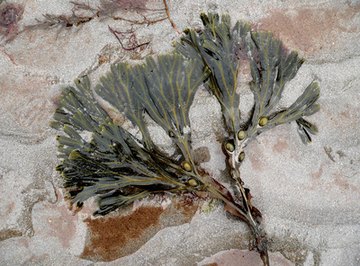
What is the structure of algae? Some types of algae are ancestors of members of the plant kingdom, while others are technically bacteria. In general, algae are photosynthetic organisms that live in aquatic environments. Algae like kelp does not have leaves, branches or vascular tissue that conducts fluids and nutrients like most land plants; an algae drawing helps to illustrate the general morphology, or structure, of plant-like algae. All algae make their own food through photosynthesis. Some algae are unicellular, while other species can grow hundreds of feet long.
General Structure of Algae
Because algae like kelp and seaweed are nonvascular, these plantlike organisms do not have true roots. Instead, a holdfast anchors an alga (singular form of algae) plant to the bottom of the water where it is growing. Thallus is the word for the main body of algae, which includes the holdfast and all the other components of the algae.
While plantlike algae do not have true roots or leaves, the flat branches of the thallus are called blades. Floats, which are balloon-like structures filled with air, are often located at the bottom of the blades, and they help keep these long, flattened structures afloat.
A stipe of an alga plant is comparable to a stem in a land plant; it forms the connection between the holdfast and the blades. Because algae are aquatic, meaning algae live in water, they doesn't need vascular tissue in the stipe to move water through the thallus. Instead, the stipe simply helps keep the algae upright so they can collect sunlight for photosynthesis.
Algae Cell Structure
Does algae have a cell wall? Yes, they do, and this call wall is composed of cellulose and other substances that give the algae form. Inside the cell walls of eukaryotic algae are three main types of organelles: the nucleus, the chloroplasts and the mitochondria.
The nucleus contains most of the genetic material of an algal cell, and the mitochondria are where food is broken down inside the cell. The last type of organelle, the chloroplasts, contain the pigments called chlorophyll that are needed for photosynthesis.
There are several other organelles present in eukaryotic algal cells, including endoplasmic reticulum, Golgi apparatus, lysosomes and vacuoles. The reproductive cells present in algae are unique because they move with the assistance of thread-like appendages called flagella. There are many different types of flagella, which vary in size, shape and arrangement.
The cellular structures of algae vary to a great degree because algae is a term that refers to a very diverse group of organisms. Prokaryotic algae, which refers to algae that are actually bacteria, lack the membrane-bound organelles present in eukaryotic algae.
Types of Algae
Varying widely in size, color and form, algae are a diverse group of organisms. Ranging from microscopic organisms to huge kelp species, the term algae refers to a group of species that have several different ancestors. Although all algae is photosynthetic, some members of the group are not members of the kingdom Protista, which includes most algae. In fact, some organisms that are called algae – cyanobacteria, or blue-green algae – are grouped with other types of bacteria in the kingdom Monera.
There are over 350,000 species in this diverse group of photosynthetic organisms. Seaweed, a familiar type of algae, is not a true plant because it lacks vascular tissues. Generally, algae is divided into groups according to the type of photosynthetic pigments it contains. Large algae, or macroalgae, is usually split into three types: green, red and brown. Small algae, also called microalgae, are single-celled diatoms and dinoflagellates.
Cyanobacteria are commonly called blue-green algae, but they are different from other algae like kelp and seaweed because they are technically bacteria. Species of cyanobacteria are associated with harmful algal blooms in both fresh and sea water across the world.
References
About the Author
Meg Schader is a freelance writer and copyeditor. She holds a Bachelor of Science in agriculture from Cornell University and a Master of Professional Studies in environmental studies from SUNY College of Environmental Science and Forestry. Along with freelancing, she also runs a small farm with her family in Central New York.
Photo Credits
seaweed image by Kevin McGrath from Fotolia.com
